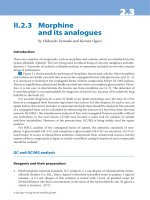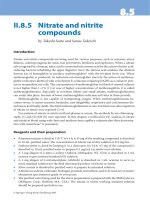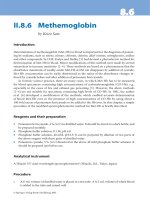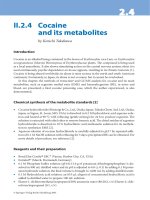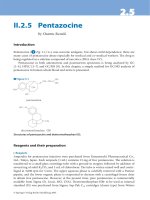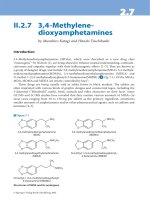Viruses called bacteriophages can infect and set in motion a genetic
Bạn đang xem bản rút gọn của tài liệu. Xem và tải ngay bản đầy đủ của tài liệu tại đây (1.61 MB, 50 trang )
VIRUSES.
Introduction.
DISCOVERY OF VIRUSES.
•
The discovery of viruses resulted from the
search for the infectious agent causing
tobacco mosaic plants and gives their leaves
a mosaic coloration.
ADOLF MEYER.
•
A German scientist demonstrated that the
disease was contagious and proposed that
the infectious agent was an unusually small
bacterium that could not be seen with a
microscope.
•
He successfully transmitted the disease by
spraying sap from infected plants onto the
healthy ones.
•
Using a microscope, he examined the sap
and was unable to identify a microbe.
D. IVANOWSKY.
•
1890: A Russian scientist proposed that tobacco
mosaic disease was caused by a bacterium that
was either too small to be trapped by a filter or
that produced a filterable toxin.
•
To remove bacteria, he filtered sap from infected
leaves.
•
Filtered sap still transmitted disease to healthy
plants.
MARTINUS BEIJERINCK.
•
1897: A Dutch microbiologist proposed that
the disease was caused by a reproducing
particle much smaller and simpler than a
bacterium.
•
He ruled out the theory that a filterable toxin
caused the disease by demonstrating that the
infectious agent in filtered sap could
reproduce.
•
Plants were sprayed with filtered sap from
disease plants > sprayed plants
developed tobacco mosaic disease >sap
from newly infected plants was used to
infect others.
WENDELL. M. STANLEY.
•
1935:An American Biologist, from the Rockefeller
Institute, crystallized the infectious particle now
known as Tobacco Mosaic Virus(TMV).
•
The purified virus precipitated in the form of
crystals.
•
He was able to show that viruses can be better
regarded as chemical matter, than as living
organisms.
•
Crystals retained the ability to infect
healthy tissue.
•
Subsequent determination of chemical
nature of TMV: Protein in combo with
nucleic, TMV were rods 300 nanometers
long, TMV was RNA surrounded by protein
coat.
GENERAL
CHARACTERISTICS.
•
Obligatory Intracellular Parasites.
•
Protein coated fragments of DNA or RNA
that have become detached from the
genomes of cells. Because they cannot
replicate on their own, they are not
organisms.
•
Viruses are generally host-specific.
•
They reproduce only within a certain host.
•
Should be as many viruses as there are
kinds of organisms.
VIRUS-HOST RANGE.
•
The host range of a virus is the spectrum of
host cells the virus can infect.
•
Some viruses have broad host ranges which
may include several species(e.g. swine flu and
rabies).
•
Some viruses have host ranges so narrow that
they can:
•
infect only one species(e.g. phages of E.coli
•
Infect only a single tissue type of one
species(e.g. human cold virus infects only
cells of the URT; AIDS virus binds only to
specific receptors on certain white blood
cells.
VIRAL SIZE.
•
In the 1950’s, TMV and other viruses were
finally observed with electron microscopes.
•
Smallest = 17 nanometers in diameter.
•
Largest = 1000 nanometers(1 micrometer) in
greatest dimension.
•
Few are barely visible at light microscope level.
•
Most are visible only via EM.
VIRAL STRUCTURE.
•
The virus or virion, is just nucleic acid
enclosed by a protein coat, it’s a complete,
fully developed infectious viral particle that
is a vehicle of transmission from one host to
another.
•
Viruses are classified by differences in the
structures of these coats.
NUCLEIC ACID- VIRAL
GENOMES.
•
Depending on the virus, viral genomes:
•
May be double-stranded DNA, single-
stranded DNA, double-stranded RNA or
single-stranded RNA.
•
Are organized as single nucleic acid
molecules that are either linear or circular.
•
May have as few as four genes or as many as
several hundred.
CAPSID AND ENVELOPE.
•
Capsid: Protein coat that encloses the viral
genome.
•
It’s structure may be rod-shaped, polyhedral
or complex.
•
Composed of many capsomeres: protein
subunits made from only one or a few types
of protein.
ENVELOPE.
•
Membrane that cloaks some viral capsid:
•
Helps viruses infect their host.
•
Derived from host cell membrane which is
usually virus-modified and contains
proteins and glycoproteins of viral origin.
GENERAL MORPHOLOGY.
•
Helical viruses.
•
Polyhedral viruses.
•
Enveloped viruses.
•
Complex viruses.
HELICAL VIRUSES.
•
Resemble long rods.
•
Maybe rigid or
flexible.
•
Viral Genome found
inside a hollow
cylindrical capsid.
•
E.G.: Ebola virus and
Rabies virus.
POLYHEDRAL VIRUSES.
•
Many-sided Capsid is
in the shape of
icosahedron( a
polyhedral with 20
triangular faces).
•
E.G.: Adenovirus, and
poliovirus.
ENVELOPED VIRUSES.
•
Roughly spherical.
•
Enveloped-helical or
enveloped polyhedral
viruses.
•
Enveloped helical =
Influenzae virus.
•
Enveloped polyhedral
= Herpes simplex
virus.
COMPLEX VIRUSES.
•
Bacteriophage.
•
Capsid(head) is
polyhedral, tail sheath
is helical.
•
Tail fibers, plate and
pin.
TAXONOMY OF VIRUSES.
•
Viruses are not organisms and are not
classified in the kingdoms of life.
•
Regarded as self-replicating portions of the
genomes of organisms.
•
In comparison to living things, vruses are
acellular(not cells and do not consist of
cells), do not metabolize energy, no
photosynthesis, cell respiration or ferment.



